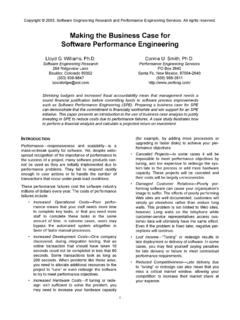Transcription of CATALYST INFORMATION CENTER
1 HOW TO USE THIS REPORT: This tool is designed to provide diversity and inclusion practitioners, diversity initiative sponsors, and employee resource group leaders with recent data to use in their efforts to build organizational business cases for diversity and inclusion. Why Diversity Matters July 2013. CATALYST INFORMATION CENTER . Leaders working to create diverse and inclusive workplaces in which women can advance must make the connection between diversity initiatives and their organization's business goals. 1. Effective business cases set the context for diversity and identify organizational challenges that must be addressed in order to create change. This tool grounds the business case for diversity in solid research. It is not a bibliography of business case research, but it is intended to provide readers with recent data to use in their efforts to build an organizational business case for diversity and inclusion. The studies included are generally from 2007 to the present, with a few additional significant studies going back to 2004.
2 New studies will be added as they are published. >>. 1. Improving Financial performance CATALYST found that companies with the most women board directors, especially those with three or more women board directors, had better financial performance than those with the fewest women board directors. Since 2004, a series of CATALYST studies has shown that companies that achieve diversity in their management and on their corporate boards attain better financial results, on average, than other companies. CATALYST 's 2011 study found that companies with the most women board directors outperformed those with the least on return on sales (ROS) by 16 percent and return on invested capital (ROIC). by 26 percent. 2. Companies with sustained high representation of women three or more women board directors in at least four of five years significantly outperformed those with no women board directors. 3. In 2007, CATALYST found that companies with more women board directors outperformed those with the least on three financial measures: return on equity (53 percent higher), return on sales (42 percent higher), and return on invested capital (66 percent higher).
3 CATALYST also showed that stronger-than-average results prevailed at companies with three or more women on their The four pillars of the corporate boards. 4. business case: Women board directors and women in senior Improve financial leadership are connected with better financial performance performance . Leverage talent CATALYST found a clear and positive correlation between the Reflect the percentage of women board directors in the past and the marketplace and build percentage of women corporate officers in the future. reputation Additionally, women board directors appeared to have a Increase innovation greater effect on increasing the percentage of line positions and group held by women than they did on staff positions. Line experience performance is necessary for advancement into CEO and top leadership positions, 5 and CATALYST 's annual Censuses show that historically women are underrepresented in these roles. 6. McKinsey found that the 89 European-listed companies with the highest proportions of women in senior leadership positions and at least two women on their boards outperformed industry averages for the Stoxx Europe 600, with 10 percent higher return on equity, 48 percent higher EBIT (operating result), and times the stock price growth.
4 7. 2013 CATALYST | 2. A study of 43 countries found that countries with a higher proportion of women on boards were more likely to have women in senior management and a smaller gender pay gap. 8. Gender-diverse boards have been shown again and again to have a positive impact on different measures of firm performance , especially when they include a critical mass of women. In a study of more than 150 German firms over five years, researchers confirmed that boards need a critical mass of about 30 percent women to outperform (as measured by return on equity) all-male boards. This translates into a magic number of about three women, based on average board size. 9. Positive return on equity occurred when boards were made up of about 30 percent women when critical mass was achieved. 10. A study that focused on 151 firms on the Australian Securities Exchange found that women had a positive impact on economic growth and social responsiveness. Firms with two or more women board directors had higher returns on equity, higher market-to-book value (M/B), and improved corporate sustainability via higher social responsiveness.
5 11. An analysis of companies in Spain found that women board appointments were positively associated with firm value in the short term as well as over a sustained period. 12. Researchers analyzed the boards of a sample of publicly listed firms in Australia and found that the presence of women directors was positively associated with higher firm value. 13. Women board directors had a positive effect on accounting performance in more than 800. publicly listed companies in Malaysia. Researchers intentionally studied both accounting performance and market performance , as market performance reflects a society's perceptions of women in business while accounting performance is informative of women's impact as board members. 14. A study that examined more than 900,000 private limited UK companies found that even after controlling for industry- and company-specific characteristics as well as the background and experience of directors, companies with women directors had a lower risk of insolvency than other companies.
6 15. A greater number of women in management and senior leadership positions was tied with better performing organizations. CATALYST 's 2004 research found that companies with the highest representation of women in senior leadership had better financial performance than companies with the lowest representation of women; the companies with the highest representation of women had 35. percent higher return on equity and 34 percent higher total return to shareholders. 16. 2013 CATALYST | 3. McKinsey measured the organizational excellence of companies in Europe, North America, and Asia by evaluating them on nine organizational criteria. When McKinsey examined the senior management teams of these companies, it found that those with three or more women had higher scores, on average, than teams with no women. McKinsey found that the score increased siginficantly once critical mass was reached about one-third women. 17. Researchers examined stock prices after the appointment of women to senior leadership positions in companies and found that investors responded positively, especially when the company was in a female-dominated industry.
7 The naming of men to senior leadership positions did not lead to the same significant positive impact on stock prices. Furthermore, the study found no evidence that female appointments caused share prices to suffer in reaction. 18. Using a large matched employee/employer dataset in Italy, researchers found a robust positive association between female leadership and firm performance , measured by sales per worker, value added per worker, and total factor productivity when firms' labor forces had sufficiently high proportions of women. Furthermore, female CEOs and executives led to wage increases for women at higher levels of the firms, as they countered pre-existing wage discrimination likely created by male executives. 19. Researchers at Columbia Business School and the University of Maryland found that a higher proportion of women in senior management, not including the CEO, was associated with better firm performance , especially at organizations involved with innovation.
8 20. An analysis of large and Canadian companies found that companies operating in complex environments generated significant returns, amounting to a robust 6 percent overall return over a three-year period, when they had a high proportion of women officers, compared to companies with low representation of women officers. 21. Other researchers found that in 2008 there was a positive relationship between firm performance and the level of female participation in management at private-owned companies in China's security exchanges. 22. Another 2008 study on what made companies resistant to the global market crash found that in the French CAC 40, the more women a company had in management positions, the less its share price fell. 23. Building off five of their previous studies, researchers at Pepperdine University found that organizations on Fortune's list of the 100 Most Desirable MBA Employers for women outperformed the industry medians on numerous financial measures, including: Profits as a percentage of revenue: 55 percent of the companies were higher than the median, 36 percent were lower, and 11 percent were tied.
9 Profits as a percentage of assets: 50 percent were higher than the median, 28 percent were lower, and 23 percent were tied. 2013 CATALYST | 4. Profits as a percentage of equity: 59 percent were higher than the median, 30 percent were lower, and 11 percent were tied. 24. Companies with women CEOs or heads have experienced better financial performance . Forbes examined the stock performance of the 26 publicly traded companies headed by women on its 2010 Power Women 100 list and found that, on average, companies in the group outperformed their industries by 15 percent and the overall market by 28 percent. 25. A study in Finland on large firms found that those with women CEOs were, on average, about 10 percent more profitable than corresponding companies with men CEOs. 26. In 2009, USA Today compared the stocks of 13 Fortune 500 companies with women CEOs to the stocks of the overall S&P 500 and found that the women-led companies were up an average of 50 percent, while the S&P 500 was up 25 percent.
10 27. In 2009, the Economic Times in India conducted a study of the top 30 firms on the Bombay Stock Exchange and found that those with women promoter CEOs (leaders of family-owned businesses) fared better in annual growth rates for the previous five years than the Bombay Stock Exchange 30 as a whole. 28. Mixed-gender teams led to higher performance in a field study. A field study experiment of undergraduate students in international business at the Amsterdam College of Applied Sciences found that teams with an equal mix of men and women outperformed male-dominated teams in profits and sales. performance peaked when a team had about 55 percent women. 29. Beyond gender, other dimensions of diversity are also found to be good for business: race, board member background, LGBT identity, nationality. A study found that a racially diverse workforce was positively associated with more customers, increased sales revenue, greater relative profits, and greater market share.









